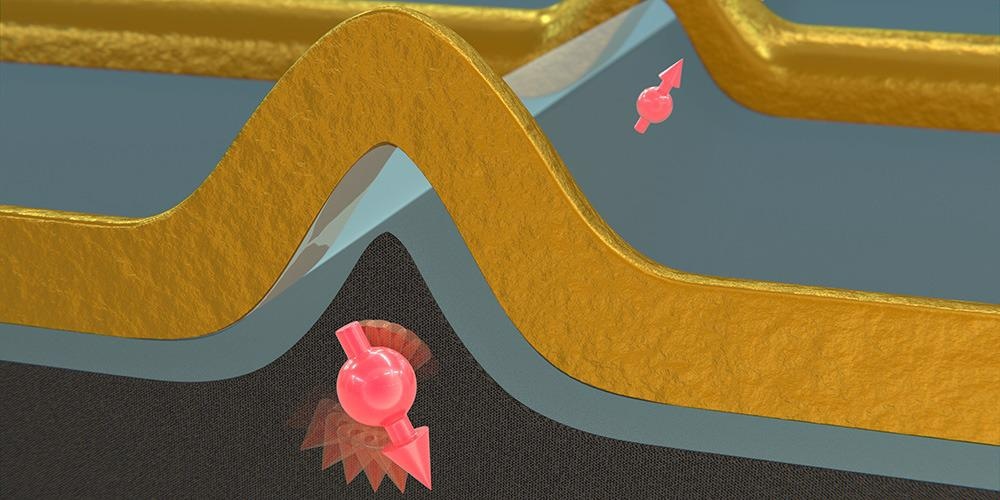Quantum bits, also known as qubits, are the smallest units of data in a quantum computer. Presently, scalability is one of the biggest hurdles in creating this type of powerful computer. However, a research team at the University of Basel, collaborating with the IBM Research Laboratory in Rüschlikon, has made an advance in this area.
 The newly developed qubits are based on so-called holes (red) whose spin (arrow) in one or the other direction stores the information. They are arranged in an architecture based on silicon transistors. Image Credit: NCCR Spin.
The newly developed qubits are based on so-called holes (red) whose spin (arrow) in one or the other direction stores the information. They are arranged in an architecture based on silicon transistors. Image Credit: NCCR Spin.
Quantum computers have unparalleled computing power, but until now, prototypes have been created on merely a few computing units. Manipulating the potential of this advanced generation of computers necessitates merging large numbers of qubits.
At one time, scalability issues impacted classic computers, as well. That was resolved with transistors incorporated into silicon chips.
The research group guided by Dr. Andreas Kuhlmann and Professor Dominik Zumbühl from the University of Basel has currently developed silicon-based qubits that are quite similar in structure to standard silicon transistors. The scientists reported their findings in Nature Electronics.
Building on Classic Silicon Technology
In traditional computers, the solution to the scalability issue was in silicon chips, which currently include billions of “fin field-effect transistors” (FinFETs). These FinFETs are sufficiently small for quantum applications; at extremely low temperatures close to absolute zero (0 kelvin or -273.15°C), a single electron with a negative charge or a “hole” with a positive charge can serve as a spin qubit.
Spin qubits collect quantum data in two states; spin-down (intrinsic angular momentum down) and spin-up (intrinsic angular momentum up).
The qubits made by Kuhlmann’s group are founded on the FinFET architecture and utilize holes as spin qubits. As opposed to electron spin, hole spin found in silicon nanostructures can be instantly manipulated with rapid electrical signals.
Potential for Higher Operating Temperatures
Another big hurdle to scalability is temperature; earlier qubit systems had to work at a very low range of approximately 0.1 kelvin. Regulating each qubit necessitates extra measuring lines to attach the control electronics at ambient temperature to the qubits in the cryostat—a cooling unit that produces very low temperatures.
The number of these measuring lines is restricted as each line generates heat. This unavoidably forms a bottleneck in the wiring, which, in turn, creates a boundary to scaling.
Avoiding this “wiring bottleneck” is one of the foremost goals of Kuhlmann’s research team, and necessitates measurement and control electronics to be developed straight into the cooling unit.
However, integrating these electronics requires qubit operation at temperatures above 1 kelvin, with the cooling power of the cryostats increasing sharply to compensate for the heat dissipation of the control electronics.
Dr. Leon Camenzind, Department of Physics, University of Basel
Simon Geyer, a doctoral student who shares lead authorship of the research paper with Camenzind, adds, “We have overcome the 4 kelvin-mark with our qubits, reaching the boiling point of liquid helium. Here we can achieve much greater cooling power, which allows for integration of state-of-the-art cryogenic control technology.”
Close to Industry Standards
Utilizing established technology, such as FinFET architecture, to construct a quantum computer has the potential for scaling up to very large quantities of qubits.
Our approach of building on existing silicon technology puts us close to industry practice.
Dr. Andreas Kuhlmann, Study Lead, University of Basel
The samples were developed at the Binnig and Rohrer Nanotechnology Center at the IBM Research Zurich laboratory in Rüschlikon, a partner of the NCCR SPIN, which is established at the University of Basel and counts the research group as a member.
Journal Reference:
Camenzind, L. C., et al. (2022) A hole spin qubit in a fin field-effect transistor above 4 kelvin. Nature Electronics. doi.org/10.1038/s41928-022-00722-0.